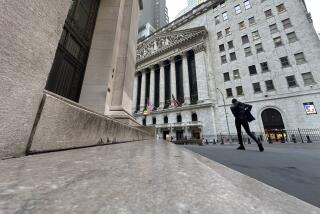Economic news lifts Wall Street
- Share via
NEW YORK — Wall Street appears to have put its “panic mode” on pause.
Stocks moved sharply higher for a second straight session Monday as the federal government’s rescue of Citigroup Inc. and President-elect Barack Obama’s pledge to enact a sizable economic-stimulus plan soothed investors’ jittery nerves.
The Dow Jones industrial average leapt almost 400 points, bringing its two-day gain to nearly 900 points, or 11.8%. That’s the best two-day gain since the Dow soared 16.6% in the two days following the Oct. 19, 1987, market crash.
Market watchers reacted cautiously to the rally, however, pointing out that stocks had been beaten down so badly in last week’s fear-driven sell-off that any rebound was likely to be strong.
“Bear-market rallies are like this -- they’re huge. It’s not a new bull market,” said Phil Roth, market analyst at brokerage Miller Tabak & Co.
Roth said the rally was triggered by Obama’s strongly worded promise to boost the economy, while the naming of his economic team removed a smidgen of uncertainty shadowing the market.
“The financial issues are being addressed,” Roth said. “Right now, people are happy that something is being done.”
Financial stocks were perhaps the biggest beneficiary of the government’s agreement Sunday to guarantee more than $300 billion in Citigroup’s troubled assets.
The Standard & Poor’s financial-sector index bounded a record 18.5%, and Citigroup jumped $2.18, or 58%, to $5.95.
But the market and especially the financial sector are likely to remain under pressure, experts said.
Stocks experienced a similar surge in early October, but the rally lacked staying power. Indeed, the record one-day gain for the Dow was 11.1% on Monday, Oct. 13, in response to an earlier financial rescue effort cobbled together on a Sunday night.
Some saw danger signs in the Citigroup bailout. The need for the government to backstop a large chunk of assets at a major bank illustrates the depth of potential losses facing other financial giants, noted David Ellison, chief investment officer of the FBR mutual-fund group.
“It tells you that conditions are not good,” Ellison said. All the big banks “ate at the same table the last five years.”
Under the rescue plan, the government agreed to invest an additional $20 billion in Citigroup, on top of $25 billion previously committed. It also agreed to absorb the first $29 billion in losses of a portfolio of $306 billion in deeply troubled assets.
After that, the government would shoulder 90% of any additional write-downs, with Citigroup responsible for the other 10%.
Citigroup’s stock plummeted 60% last week. Although the giant bank had sufficient capital to cover near-term losses, it appeared to come under fire from short sellers who profit from falling stock prices.
That eroded confidence in the company and risked setting off an exodus of customers and trading partners.
Other large financial institutions -- including JPMorgan Chase, Bank of America, Goldman Sachs and Morgan Stanley -- are in better financial shape than Citigroup, lessening the odds that their stocks could be targeted.
But then, few people expected Citigroup’s stock to come under assault a week ago.
“Anybody is vulnerable to attack,” said Anton Schutz, head of Mendon Capital Advisors in Rochester, N.Y.
Some analysts said that although the government would continue to bail out companies considered too big to fail, it would let smaller institutions collapse, potentially setting a double standard in the banking industry.
“What’s worrisome about this one is that they’ll have to let some medium-size bank go just to show that not everyone can get” a bailout, said Martin Mayer, a banking expert at the Brookings Institution.
Investors’ continued uneasiness was on display in the Treasury market, where the yield on three-month T-bills remained at a low 0.015%. That shows that investors are willing to give up virtually any return on their money in exchange for having a safe place to park it.
The Dow rose 396.97 points, or 4.9%, to 8,443.39. The Standard & Poor’s 500 index climbed 51.78 points, or 6.5%, to 851.81, and is up 13.2% in the last two trading sessions.
The Nasdaq composite index advanced 87.67 points, or 6.3%, to 1,472.02.
Sectors that do well in an economic recovery -- such as consumer-discretionary items and materials -- rose strongly.
Energy stocks moved up, helped by a $4.57-a-barrel increase in the price of crude oil to $54.50.
Among bank stocks, Bank of America rose $3.12, or 27%, to $14.59. Goldman Sachs rocketed $14.11, or 26.5% to $67.42. Morgan Stanley shot up $3.33, or 33%, to $13.38.
--
--
Obama unveils economic team
The typically cautious experts have been asked to use radical means to fix the economy. PAGE A1
More to Read
Inside the business of entertainment
The Wide Shot brings you news, analysis and insights on everything from streaming wars to production — and what it all means for the future.
You may occasionally receive promotional content from the Los Angeles Times.










